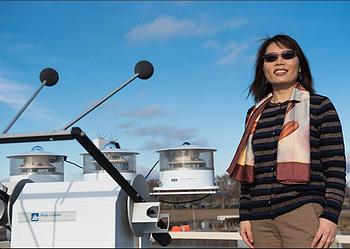
RICHLAND, Washington, February 19, 2018 (ENS) – Tiny particles fuel powerful storms and influence weather much more than has been previously understood, finds a new study published in the journal “Science.”
The research focuses on the power of minute airborne particles known as aerosols, which can come from urban and industrial air pollution as well as wildfires.
Scientists have known that aerosols may play an important role in shaping weather and climate, but the new study shows that the smallest of particles have an outsize effect.
Particles smaller than 1,000th the width of a human hair can cause storms to intensify, clouds to grow and more rain to fall, the researchers have learned.

“We showed that the presence of these particles is one reason why some storms become so strong and produce so much rain. In a warm and humid area where atmospheric conditions are otherwise very clean, the intrusion of very small particles can make quite an impact,” said lead author Jiwen Fan of the U.S. Department of Energy’s Pacific Northwest National Laboratory in Richland.
Fan led 21 authors from 15 institutions in the United States, China, Brazil, Israel and Germany in this research.
The findings are based on unique data made possible by the GoAmazon research campaign, where scientists made ground-based and airborne measurements related to climate during 2014-2015.
The campaign was run by the Atmospheric Radiation Measurement Climate Research Facility, a Department of Energy Office of Science facility.
The study capitalized on data from an area of the Amazon that is pristine except for the region around Manaus. With a population of more than two million people it is the largest city in the Amazon.
The Amazon rainforest provided a unique natural lab to study effects of aerosols. The setting gave scientists the rare opportunity to look at the impact of pollution on atmospheric processes in a pre-industrial environment and pinpoint the effects of the particles apart from other factors such as temperature and humidity.
The scientists studied the role of ultrafine particles less than 50 nanometers wide in the development of thunderstorms.
Similar but larger particles are known to play a role in feeding powerful, fast-moving updrafts of air from the land surface to the atmosphere, creating the clouds that play a central role in the formation of water droplets that fall as rain.

But scientists had not observed until now that particles smaller than 50 nanometers, such as the particles produced by vehicles and industrial processes, could have the same effects.
The new study revealed that these small particles can invigorate clouds in a much more powerful way than their larger counterparts.
Through detailed computer simulations, the scientists showed how the smaller particles have a powerful impact on storm clouds.
When larger particles are not present high in a warm and humid environment, it opens opportunities for the smaller particles to form cloud droplets.
A low concentration of large particles high in a warm and humid environment with relative humidity beyond 100 percent, contributes to high levels of excessive water vapor, allowing ultrafine particles to transform into cloud droplets.
While the particles are small in size, they are large in number, and they can form many small droplets on which the excess water vapor condenses.
That condensation releases more heat, which makes the updrafts much more powerful. More warm air is pulled into the clouds, pulling more droplets aloft and producing more ice and snow pellets, lightning, and rain.
The result is what Fan calls “invigorated convection,” producing stronger storms.
“We’ve shown that under clean and humid conditions, like those that exist over the ocean and some land in the tropics, tiny aerosols have a big impact on weather and climate and can intensify storms a great deal,” said Fan, an expert on the effects of pollution on storms and weather.
“More broadly, the results suggest that from pre-industrial to the present day, human activity possibly may have changed storms in these regions in powerful ways,” he said.
In addition to scientists from PNNL, the paper includes authors from the Hebrew University of Jerusalem, the University of Maryland, Brookhaven National Laboratory, Beijing Normal University, the Instituto Nacional de Pesquisas Espaciais in Brazil, Harvard University, the Beijing Municipal Weather Modification Office, the Universidade de São Paulo in Brazil, the Chinese Academy of Meteorological Sciences, the Federal University of Alagoas in Brazil, the Max Planck Institute for Chemistry, Johannes Gutenberg University in Germany, and Amazonas State University in Brazil.
The work was supported in part by the U.S. Department of Energy’s Office of Science.
Copyright Environment News Service (ENS) 2018. All rights reserved.
